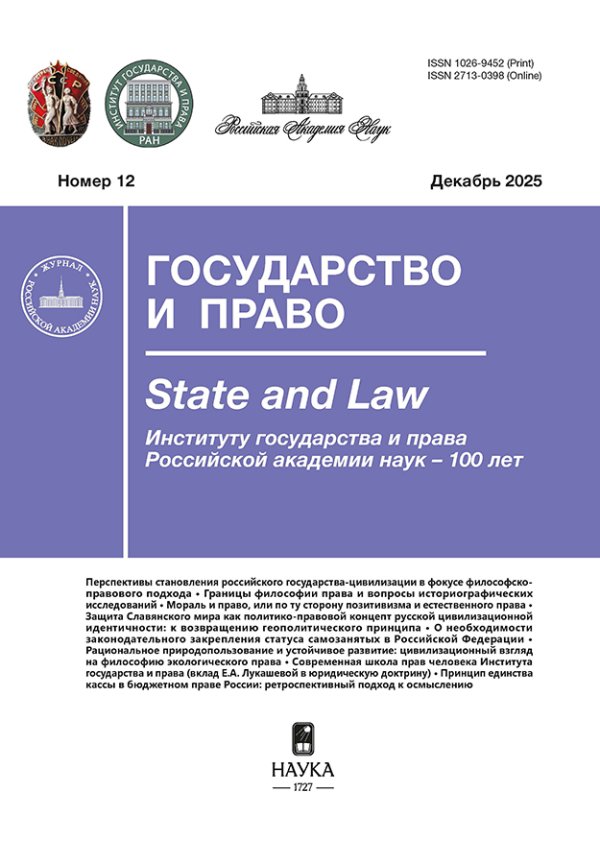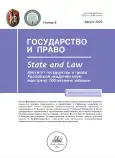Features of the federal structure of the Australian Union (in the context of the principle of subsidiarity)
- Authors: Irkhin I.V.1
-
Affiliations:
- Kuban State University
- Issue: No 8 (2023)
- Pages: 154-165
- Section: Abroad
- URL: https://journals.rcsi.science/1026-9452/article/view/141271
- DOI: https://doi.org/10.31857/S102694520026147-2
- ID: 141271
Cite item
Full Text
Abstract
References
- Гуляков А.Д. Пионерский федерализм в Австралии: особенности становления и динамика развития // Известия высших учебных заведений. Поволжский регион. Общественные науки. 2015. № 3 (35). С. 11, 12.
- Гуляков А.Д., Саломатин А.Ю. Роль высших судов в развитии переселенческих федеративных государств (на примере США и Австралии) // Вестник Университета им. О.Е. Кутафина (МГЮА). 2017. № 4. С. 131.
- Каневская Г.И. Путь к федерации // Россия и АТР. 2000. С. 136. URL: https://cyberleninka.ru/article/n/put-k-federatsii/viewer).
- Мочалов А.Н. Сравнительный федерализм России и Австралии. Екатеринбург, 2012. С. 156.
- Пименова О.И. Правовая интеграция в ЕС и ее «национальное» измерение // Право. Журнал ВШЭ. 2017. № 3. С. 149.
- Пименова О.И. Субсидиарность как принцип реализации совместных законодательных полномочий: опыт Европейского Союза и перспективы его адаптации в российской системе разграничения полномочий по предметам совместного ведения. М., 2015. С. 28.
- Цыремпилова Е. Б.-М. Порядок разграничения компетенции между Союзом и штатами в Австралии: конституционно-правовое исследование: дис. … канд. юрид. наук. Улан-Удэ, 2019. С. 46, 47, 91, 92.
- Angus J. O’Brien Wither Federalism: The Consequences and Sustainability of the High Court’s Interpretation of Commonwealth Powers // Australasian Parliamentary Review, Spring 2008. Vol. 23 (2). P. 173.
- Beach W. The Australian Federal Constitution. 1899. Vol. 14. No. 4. P. 679.
- Bell P. How Local Government Can Save Australia’s Federal System. In: Federalism and Regionalism in Australia: New Approaches, New Institutions? / ed. by A.J. Brown, J.A. Bellamy. Sydney, NY, 2006. P. 172, 176.
- Borońska-Hryniewiecka K. Legitimacy through Subsidiarity? The Parliamentary Control of EU Policy-Making // Polish Political Science Review. 2013. Vol. 1 (1). P. 87.
- Brown A.J. Federalism, Regionalism and the Reshaping of Australian Governance. In: Federalism and Regionalism in Australia: New Approaches, New Institutions? / ed. by A.J. Brown, J.A. Bellamy. Sydney, NY, 2006. P. 18.
- Brown A.J. Taking Subsidiarity Seriously: What Role for the States? In: Federalism and Regionalism in Australia: New Approaches, New Institutions? / ed. by A.J. Brown, J.A. Bellamy. Sydney, NY, 2006. P. 160, 162.
- Burbidge D. The Inherently Political Nature of Subsidiarity // The American Journal of Jurisprudence. 2017. Vol. 62. No. 2. P. 144.
- Cheryl Saunders, Adrienne Stone. The Oxford Handbook of the Australian Constitution. Oxford University Press, 2018. P. 127.
- Deem J., Hollander R., Brown A. Subsidiarity in the Australian Public Sector: Finding Pragmatism in the Principle // Australian Journal of Public Administration. 2015. Vol. 74. P. 419.
- Definition and Limits of the Principle of Subsidiarity. Report prepared for the Steering Committee on Local and Regional Authorities. Local and Regional Authorities in Europe. No. 55. P. 11.
- Evans M. Subsidiarity and Federalism: A Case Study of the Australian Constitution and Its interpretation. P. 203. URL: https://link.springer.com/chapter/10.1007/978-94-017-8810-6_10
- Evans M. The Use of the Principle of Subsidiarity in the Reformation of Australia’s Federal System of Government. This thesis is presented for the Degree of Doctor of Philosophy of Curtin University. 2012. P. 294, 313, 316. URL : https://espace.curtin.edu.au/handle/20.500.11937/28
- Geoffrey de Q Walker. The Seven Pillars of Centralism: Federalism and the Engineers’ Case. URL: http://classic.austlii.edu.au/au/journals/SGSocUphAUCon/2002/4.html
- Goldsworthy J. Constitutional Cultures, Democracy, and Unwritten Principles // University of Illinois Law Review. 2012. Vol. 3. P. 685.
- Gussen B.F. Australian Constitutionalism between Subsidiarity and Federalism // Monash University Law Review. Vol. 42. No. 2. P. 396.
- Kirby M. Deakin – Popular Sovereignty and the True Foundation of the Australian Constitution. 1997. P. 2. URL: https://www.hcourt.gov.au/assets/publications/speeches/former-justices/kirbyj/kirbyj_deakin2.htm
- Llach J. What Role for Subsidiarity in Emerging Schemes of Governance. Governance in a Changing World: Meeting the Challenges of Liberty, Legitimacy, Solidarity, and Subsidiarity Pontifical Academy of Social Sciences // Extra Series, 14 Vatican City 2013. P. 1, 2. URL: www.pass.va/content/dam/scienzesociali/pdf/es14/es14-llach.pdf (дата обращения: 24.10.2019).
- Lynch A., Williams G. Beyond a Federal Structure: Is a Constitutional Commitment to a Federal Relationship Posiible? // UNSW Law Journal. 2008. Vol. 31 (2). P. 398, 403, 404.
- Meale D. The History of the Federal Idea in Australian Constitutional Jurisprudence: A Reappraisal // The Australian Journal of Law and Society. 1992. Vol. 8. P. 45, 46).
- Pierce J. A Sketch of Australian Constitutional History. P. 341.
- Reform of the Federation White Paper. 2014. P. 17, 20.
- Select Committee on the Reform of the Australian Federation: Australia's Federation: an agenda for reform. 2011. Senate Printing Unit, Parliament House, Canberra. P. 8.
- Smith C. Quantifying the Costs and Benefits of Change: Toward A Methodology? / ed. by A.J. Brown, J.A. Bellamy. Sydney, NY, 2006. P. 206.
- Walker G. Ten Advantages of a Federal Constitution and How to Make the Most of Them. SGSocUphAUCon. 1998. Vol. 14. URL: https://www.cis.org.au/wp-content/uploads/2015/07/pm49.pdf
Supplementary files










